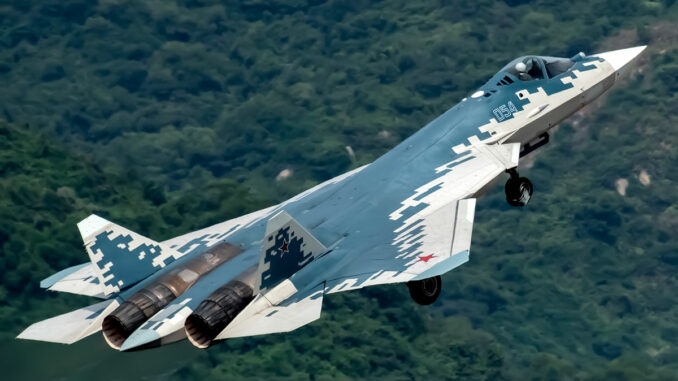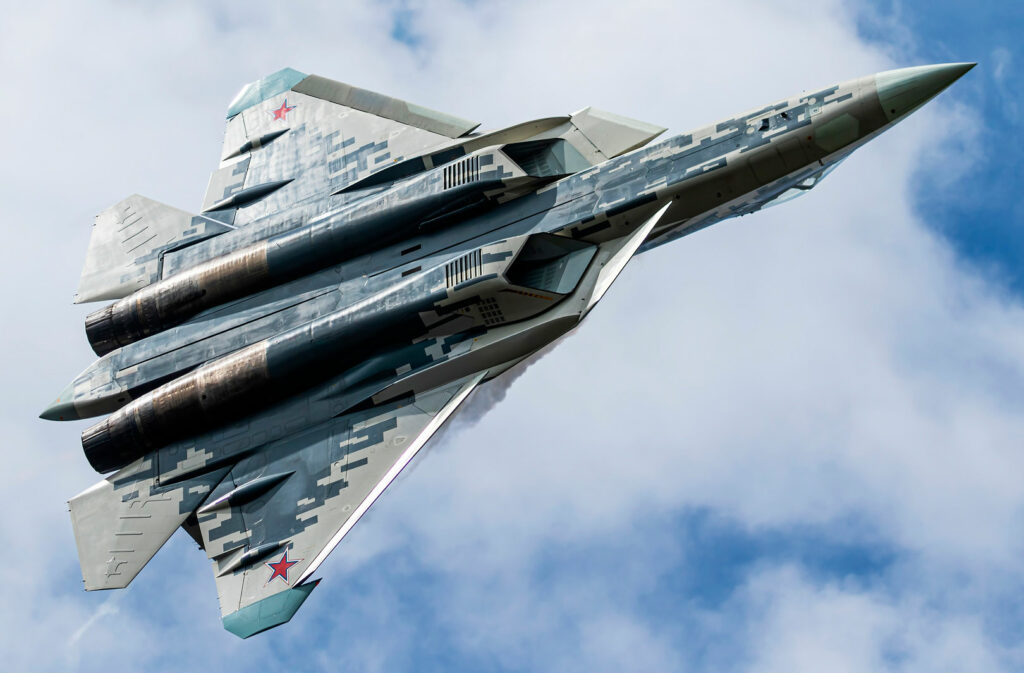
Russia is planning to develop a sixth-generation fighter prototype by 2050, according to Evgeny Fedosov, scientific director of the Aviation Systems Research Institute (GosNIIAS). This announcement comes as the country is experiencing difficulties with its fifth-generation fighter, the Su-57.
Russia plans to design a sixth-generation fighter by 2050, despite the obstacles encountered with the Su-57. The latter, intended to rival aircraft such as the American F-22 Raptor, is facing problems with production, performance and export. Russian ambitions in military aviation raise questions about the country’s feasibility and strategic priorities.
Russian ambitions for a sixth-generation fighter
Evgeny Fedosov has revealed that Russia is planning to develop a sixth-generation fighter, with a prototype expected around 2050. This initiative aims to anticipate future armed conflicts and maintain Russia’s competitiveness in the field of military aviation. However, this announcement comes at a time when the Su-57, a fifth-generation fighter, is experiencing significant difficulties.

The Su-57: a fifth-generation fighter in trouble
The Su-57, designated “Felon” by NATO, is the result of a Soviet program relaunched by Russia in the early 2000s to respond to technological developments in American fighters such as the F-22 Raptor and the F-35 Lightning II. Officially presented as a fifth-generation aircraft, the Su-57 is supposed to combine stealth, super-maneuverability, advanced avionics and the ability to operate in a networked warfare environment. But in reality, its operational serviceability and technical maturity are far from reaching the standards of its Western equivalents.
Almost experimental industrial production
According to the data available up to 2024, only 22 examples of the Su-57 have been built, including around ten prototypes (T-50). The series production version was only really delivered from 2021, in very small numbers. By way of comparison, the United States has produced more than 900 F-35s since 2011, and China is said to already have around 250 J-20 Chengdu aircraft in service. Russia initially planned to produce 76 Su-57s by 2027, a target that is now unrealistic due to budgetary, industrial and logistical constraints.
The low production rate is the result of dependence on a fragmented industrial ecosystem, some key components of which were previously manufactured in Ukraine (avionics, electronic equipment). In addition, the Western sanctions imposed after the invasion of Crimea (2014), and then extended after 2022, have severely restricted Russia’s access to Western dual-use technologies (processors, optoelectronics, etc.). This further slows down the production chain.
Performance still far from expected standards
The Su-57 was to be powered by the Izdeliye 30 engine, a new-generation turbofan designed to offer increased vector thrust, better infrared stealth, reduced consumption and supersonic cruising speed without afterburner (supercruise). However, this engine is not yet ready for reliable mass production. To date, the majority of Su-57s are flying with the Saturn AL-41F1 engine, derived from that of the Su-35, with a maximum afterburner thrust of 147 kN. This engine does not allow the Su-57 to achieve its announced theoretical performance.
In terms of stealth, the Su-57 has a radar signature (RCS) estimated at between 0.5 m² and 1 m², according to independent studies. By way of comparison, the F-22 has an RCS of less than 0.01 m². This weakness is due to a design that is still partially inherited from the Su-27/Su-35, in particular the integration of weapons in not very discreet bays and the use of less efficient composite materials. In terms of avionics, systems such as the AESA N036 Byelka radar, which is supposed to be equivalent to the American AN/APG-77, are still in the testing phase or are only integrated on a very small scale.
Export blocked by geopolitical and technical reality
Initially, the Su-57 was to be developed in cooperation with India under the name FGFA (Fifth Generation Fighter Aircraft). This partnership was abandoned in 2018 by New Delhi, citing the prototype’s lack of performance, lack of radar discretion and repeated delays. Since then, Russia has been trying to revive bilateral export projects, notably with Algeria, which is said to have signed a contract for 14 units. However, no delivery has yet been confirmed.
The American sanctions (CAATSA) make it difficult for countries allied with the United States or dependent on the international banking system in dollars to acquire Russian military equipment. In addition, the lack of international certification, doubts about logistical support, training and long-term maintenance pose real limits to the attractiveness of the Su-57. The few attempts to demonstrate the aircraft abroad, such as at the MAKS air show or in Dubai, have not convinced international delegations.
Consequences for Russian air doctrine
The inability to deploy the Su-57 on a large scale weakens Russia’s ambition to field an air force comparable to that of NATO. The operations in Ukraine have highlighted an air doctrine still largely based on fourth-generation aircraft (Su-30SM, Su-34, Su-35), operating at a distance to avoid modern anti-aircraft systems such as NASAMS, IRIS-T or Patriot. In the absence of reliable stealth fighters, Russian air superiority is becoming difficult to sustain in a high-intensity conflict.
Moreover, this compromises the industrial viability of the program. Without export orders and mass production, the unit cost of the Su-57 could reach between 35 and 45 million euros, making the platform uncompetitive against the F-35 (estimated at 80 million dollars) but with a proven and shared logistics ecosystem.
Consequences of the Su-57’s difficulties on future ambitions
The operational and industrial limitations of the Su-57 Felon are not just a one-off failure in the development of a fighter aircraft. They have profound repercussions on Russia’s strategic projection capability in the short and medium term, as well as on the long-term credibility of its aeronautics industry. These impacts concern export policy, military employment doctrines and future investment programs, particularly that of the sixth-generation fighter project announced for 2050.
Shaken credibility in the arms market
Russia has long been one of the world’s top three arms exporters, with annual sales averaging around €13 to €15 billion between 2010 and 2020. It was ranked second in the world behind the United States, according to data from the Stockholm International Peace Research Institute (SIPRI). However, the partial failure of the Su-57 weakens this position in a strategic segment: that of advanced aircraft.
The lack of firm orders, India’s abandonment of the FGFA program, and uncertainty surrounding deliveries to Algeria highlight a loss of confidence among international customers in new-generation Russian weapons systems. Direct competitors such as Lockheed Martin (F-35), Dassault Aviation (Rafale) and SAAB (Gripen E) benefit not only from proven technical superiority, but also from stable logistical, political and industrial support, which Russia has been unable to guarantee since 2022.
Moreover, the war in Ukraine has revealed operational vulnerabilities in the use of Russian aircraft, which are often forced to operate far from the front lines for fear of modern anti-air defenses. This reality, visible in the conspicuous absence of the Su-57 in the critical phases of the conflict, damages the image of the effectiveness of Russian air platforms.
An undersized air force
In contemporary theaters of operation, air superiority is an essential force multiplier. However, the lack of a large fleet of stealth fighters severely limits Russia’s strike and deep reconnaissance capabilities. The Su-57, initially intended to partially replace the Su-27, MiG-29 and Su-35 in stealth penetration missions, is not available in sufficient numbers to fulfill this role.
The campaigns in Syria and then Ukraine confirmed that Russia still favors doctrines based on the use of modernized fourth-generation fighters, operating at a distance with long-range air-to-ground missiles. In the absence of credible stealth coverage, this strategy makes the aircraft vulnerable to modern surface-to-air defense systems, thus reducing their tactical maneuvering room.
On a more structural level, this shortcoming prevents Russia from effectively integrating its air forces into a fifth-generation networked warfare, where data fusion, joint coordination and synchronized strikes require high-connectivity platforms. This constitutes a major handicap in the face of American Joint All-Domain Command and Control (JADC2) doctrines or equivalent systems developed by NATO.
A crowding-out effect on future programs
The development of a sixth-generation fighter relies on a solid industrial and technological base, capable of mass-producing complex systems, testing advanced materials, designing innovative engines, and integrating artificial intelligence or loyal wingman drones. The accumulated delay on the Su-57 is eroding this industrial base and could compromise Moscow’s ambitions for the post-2035 period.
Russian military programs are already constrained by significant budgetary trade-offs. Between 2021 and 2024, the Russian Ministry of Defense had to redeploy part of its funds to munitions, armor and artillery to meet the immediate needs of the Ukrainian front. This reduces the funding margins for heavy R&D projects, such as those required for the sixth generation.
Furthermore, engineering and production skills are concentrated in design offices already saturated by the modernization of existing fleets (Su-34M, Su-30SM2, MiG-35). Without generational renewal of engineers or international partnerships, development capacities risk becoming bogged down. Even projects such as the S-70 Okhotnik, the stealth drone supposed to accompany the Su-57 in training, are progressing at a very slow pace, with fewer than 10 prototypes delivered in 5 years.

Prospects and challenges for the sixth-generation fighter
The development of a sixth-generation fighter is a major ambition for Russia. However, several challenges must be met:
- Emerging technologies: the integration of advanced technologies, such as artificial intelligence and networked combat systems, is essential to meet the demands of future conflicts.
- Funding and resources: the development of a new aircraft requires considerable investment, in an economic context potentially constrained by sanctions and competing priorities.
- International collaboration: establishing partnerships with other nations or companies could be beneficial, but current geopolitical relations may limit these opportunities.
Russia’s military aviation ambitions, exemplified by the sixth-generation fighter project, are confronted with complex realities, including the persistent challenges of the Su-57 program. The success of these projects will depend on Russia’s ability to overcome these obstacles and align its technological ambitions with its industrial and economic capabilities.
War Wings Daily is an independant magazine.